2009 DODGE DAKOTA window
[x] Cancel search: windowPage 234 of 449
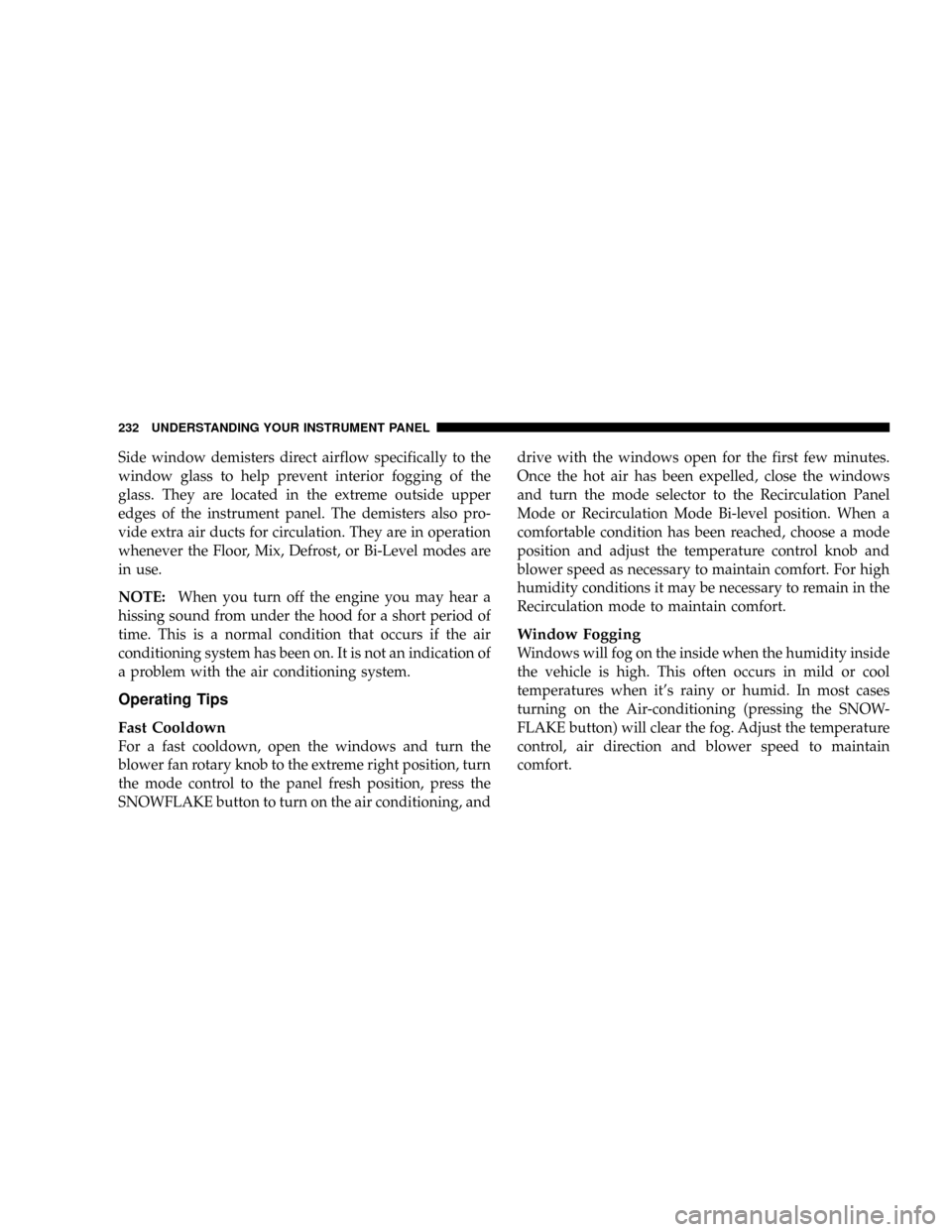
Side window demisters direct airflow specifically to the
window glass to help prevent interior fogging of the
glass. They are located in the extreme outside upper
edges of the instrument panel. The demisters also pro-
vide extra air ducts for circulation. They are in operation
whenever the Floor, Mix, Defrost, or Bi-Level modes are
in use.
NOTE:When you turn off the engine you may hear a
hissing sound from under the hood for a short period of
time. This is a normal condition that occurs if the air
conditioning system has been on. It is not an indication of
a problem with the air conditioning system.
Operating Tips
Fast Cooldown
For a fast cooldown, open the windows and turn the
blower fan rotary knob to the extreme right position, turn
the mode control to the panel fresh position, press the
SNOWFLAKE button to turn on the air conditioning, anddrive with the windows open for the first few minutes.
Once the hot air has been expelled, close the windows
and turn the mode selector to the Recirculation Panel
Mode or Recirculation Mode Bi-level position. When a
comfortable condition has been reached, choose a mode
position and adjust the temperature control knob and
blower speed as necessary to maintain comfort. For high
humidity conditions it may be necessary to remain in the
Recirculation mode to maintain comfort.
Window Fogging
Windows will fog on the inside when the humidity inside
the vehicle is high. This often occurs in mild or cool
temperatures when it's rainy or humid. In most cases
turning on the Air-conditioning (pressing the SNOW-
FLAKE button) will clear the fog. Adjust the temperature
control, air direction and blower speed to maintain
comfort.
232 UNDERSTANDING YOUR INSTRUMENT PANEL
Page 235 of 449
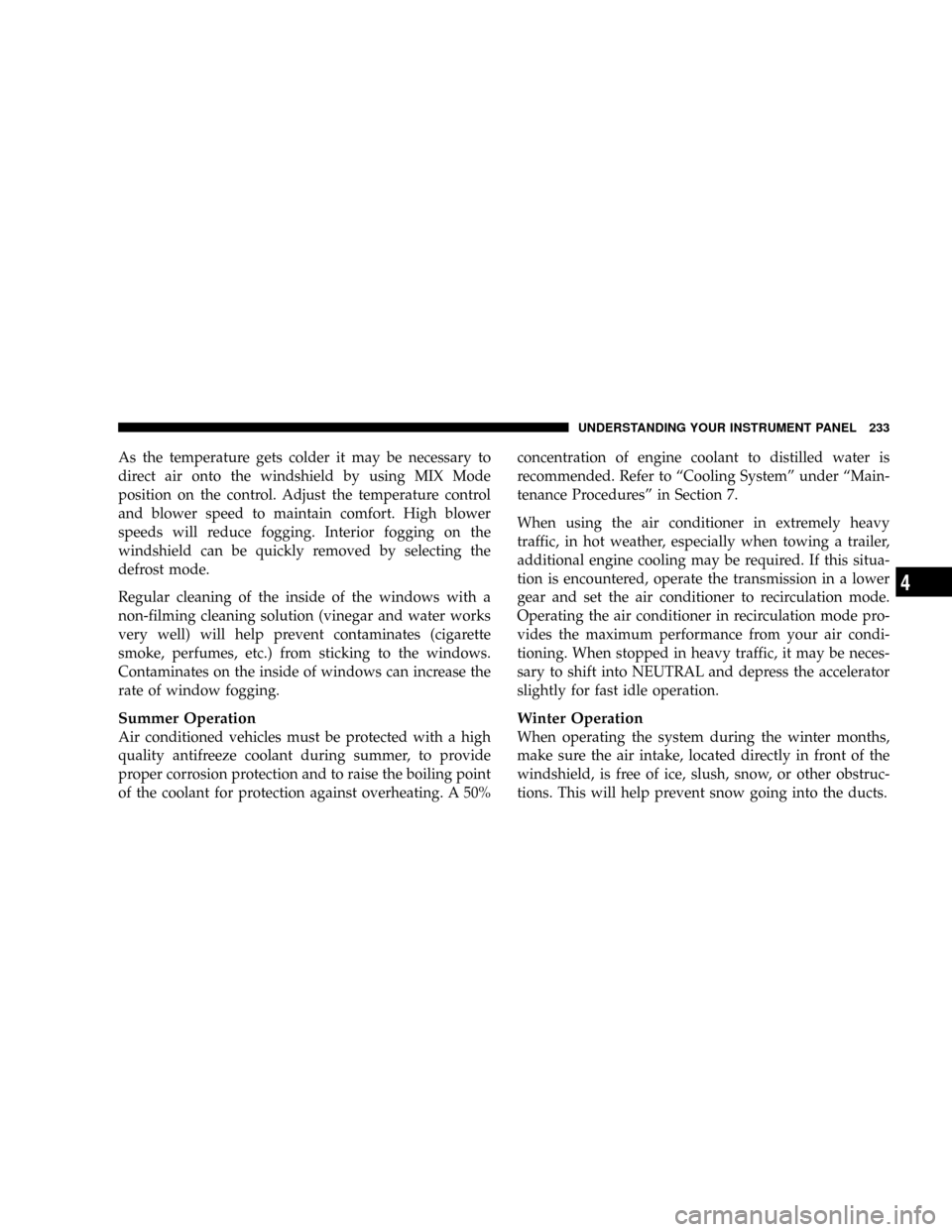
As the temperature gets colder it may be necessary to
direct air onto the windshield by using MIX Mode
position on the control. Adjust the temperature control
and blower speed to maintain comfort. High blower
speeds will reduce fogging. Interior fogging on the
windshield can be quickly removed by selecting the
defrost mode.
Regular cleaning of the inside of the windows with a
non-filming cleaning solution (vinegar and water works
very well) will help prevent contaminates (cigarette
smoke, perfumes, etc.) from sticking to the windows.
Contaminates on the inside of windows can increase the
rate of window fogging.
Summer Operation
Air conditioned vehicles must be protected with a high
quality antifreeze coolant during summer, to provide
proper corrosion protection and to raise the boiling point
of the coolant for protection against overheating. A 50%concentration of engine coolant to distilled water is
recommended. Refer to ªCooling Systemº under ªMain-
tenance Proceduresº in Section 7.
When using the air conditioner in extremely heavy
traffic, in hot weather, especially when towing a trailer,
additional engine cooling may be required. If this situa-
tion is encountered, operate the transmission in a lower
gear and set the air conditioner to recirculation mode.
Operating the air conditioner in recirculation mode pro-
vides the maximum performance from your air condi-
tioning. When stopped in heavy traffic, it may be neces-
sary to shift into NEUTRAL and depress the accelerator
slightly for fast idle operation.
Winter Operation
When operating the system during the winter months,
make sure the air intake, located directly in front of the
windshield, is free of ice, slush, snow, or other obstruc-
tions. This will help prevent snow going into the ducts.
UNDERSTANDING YOUR INSTRUMENT PANEL 233
4
Page 298 of 449

fault condition no longer exists. A system fault can occur
by any of the following scenarios: 1) Jamming due to
electronic devices or driving next to facilities emitting the
same radio frequencies as the TPM sensors; 2) Installing
some form of aftermarket window tinting that affects
radio wave signals; 3) Lots of snow or ice around the
wheels or wheel housings; 4) Using tire chains on the
vehicle; 5) Using wheels/tires not equipped with TPM
sensors.
NOTE: Your vehicle is equipped with a non-matching
full size spare wheel and tire assembly.
1. This spare tire does not have a tire pressure monitor-
ing sensor. Therefore, the TPMS will not monitor the tire
pressure in the spare tire.
2. If you install the full size spare tire in place of a road
tire that has a pressure below the low-pressure warninglimit, upon the next ignition key cycle a chime will sound
and the TPM Telltale Lamp will still turn ON due to the
low tire.
3. However, after driving the vehicle for up to 10 min-
utes above 15 mph (25 km/h), the TPM Telltale Lamp
will flash on and off for 75 seconds and then remain on
solid.
4. For each subsequent ignition key cycle, a chime will
sound and the TPM Telltale Light will flash on and off for
75 seconds and then remain on solid.
5. Once you repair or replace the original road tire, and
reinstall it on the vehicle in place of the full size spare tire,
the TPMS will update automatically and the TPM Telltale
Lamp will turn OFF, as long as no tire pressure is below
the low-pressure warning limit in any of the four active
road tires. The vehicle may need to be driven for up to
10 minutes above 15 mph (25 km/h) in order for the
TPMS to receive this information.
296 STARTING AND OPERATING
Page 304 of 449
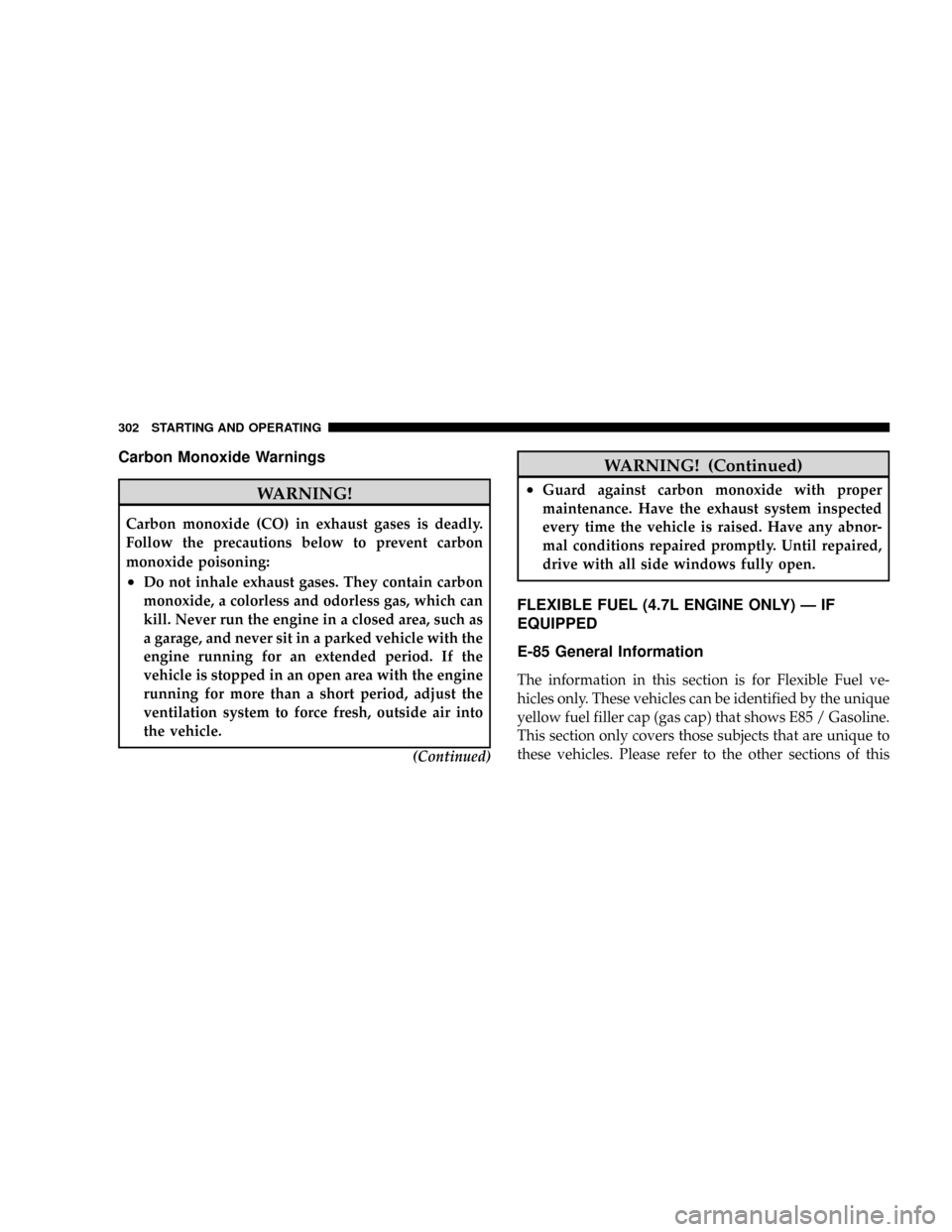
Carbon Monoxide Warnings
WARNING!
Carbon monoxide (CO) in exhaust gases is deadly.
Follow the precautions below to prevent carbon
monoxide poisoning:
²Do not inhale exhaust gases. They contain carbon
monoxide, a colorless and odorless gas, which can
kill. Never run the engine in a closed area, such as
a garage, and never sit in a parked vehicle with the
engine running for an extended period. If the
vehicle is stopped in an open area with the engine
running for more than a short period, adjust the
ventilation system to force fresh, outside air into
the vehicle.
(Continued)
WARNING! (Continued)
²Guard against carbon monoxide with proper
maintenance. Have the exhaust system inspected
every time the vehicle is raised. Have any abnor-
mal conditions repaired promptly. Until repaired,
drive with all side windows fully open.
FLEXIBLE FUEL (4.7L ENGINE ONLY) Ð IF
EQUIPPED
E-85 General Information
The information in this section is for Flexible Fuel ve-
hicles only. These vehicles can be identified by the unique
yellow fuel filler cap (gas cap) that shows E85 / Gasoline.
This section only covers those subjects that are unique to
these vehicles. Please refer to the other sections of this
302 STARTING AND OPERATING
Page 382 of 449
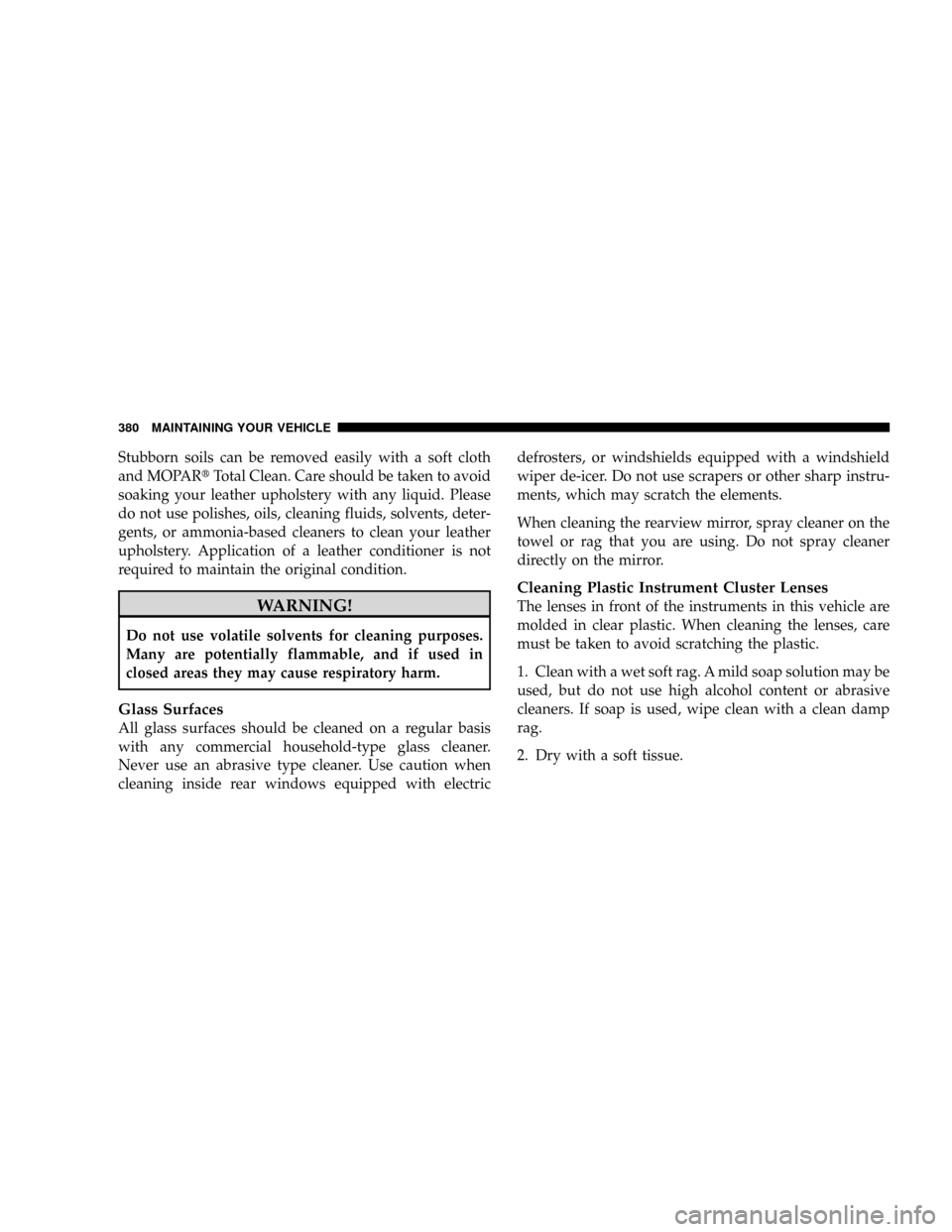
Stubborn soils can be removed easily with a soft cloth
and MOPARtTotal Clean. Care should be taken to avoid
soaking your leather upholstery with any liquid. Please
do not use polishes, oils, cleaning fluids, solvents, deter-
gents, or ammonia-based cleaners to clean your leather
upholstery. Application of a leather conditioner is not
required to maintain the original condition.
WARNING!
Do not use volatile solvents for cleaning purposes.
Many are potentially flammable, and if used in
closed areas they may cause respiratory harm.
Glass Surfaces
All glass surfaces should be cleaned on a regular basis
with any commercial household-type glass cleaner.
Never use an abrasive type cleaner. Use caution when
cleaning inside rear windows equipped with electricdefrosters, or windshields equipped with a windshield
wiper de-icer. Do not use scrapers or other sharp instru-
ments, which may scratch the elements.
When cleaning the rearview mirror, spray cleaner on the
towel or rag that you are using. Do not spray cleaner
directly on the mirror.
Cleaning Plastic Instrument Cluster Lenses
The lenses in front of the instruments in this vehicle are
molded in clear plastic. When cleaning the lenses, care
must be taken to avoid scratching the plastic.
1. Clean with a wet soft rag. A mild soap solution may be
used, but do not use high alcohol content or abrasive
cleaners. If soap is used, wipe clean with a clean damp
rag.
2. Dry with a soft tissue.
380 MAINTAINING YOUR VEHICLE
Page 433 of 449
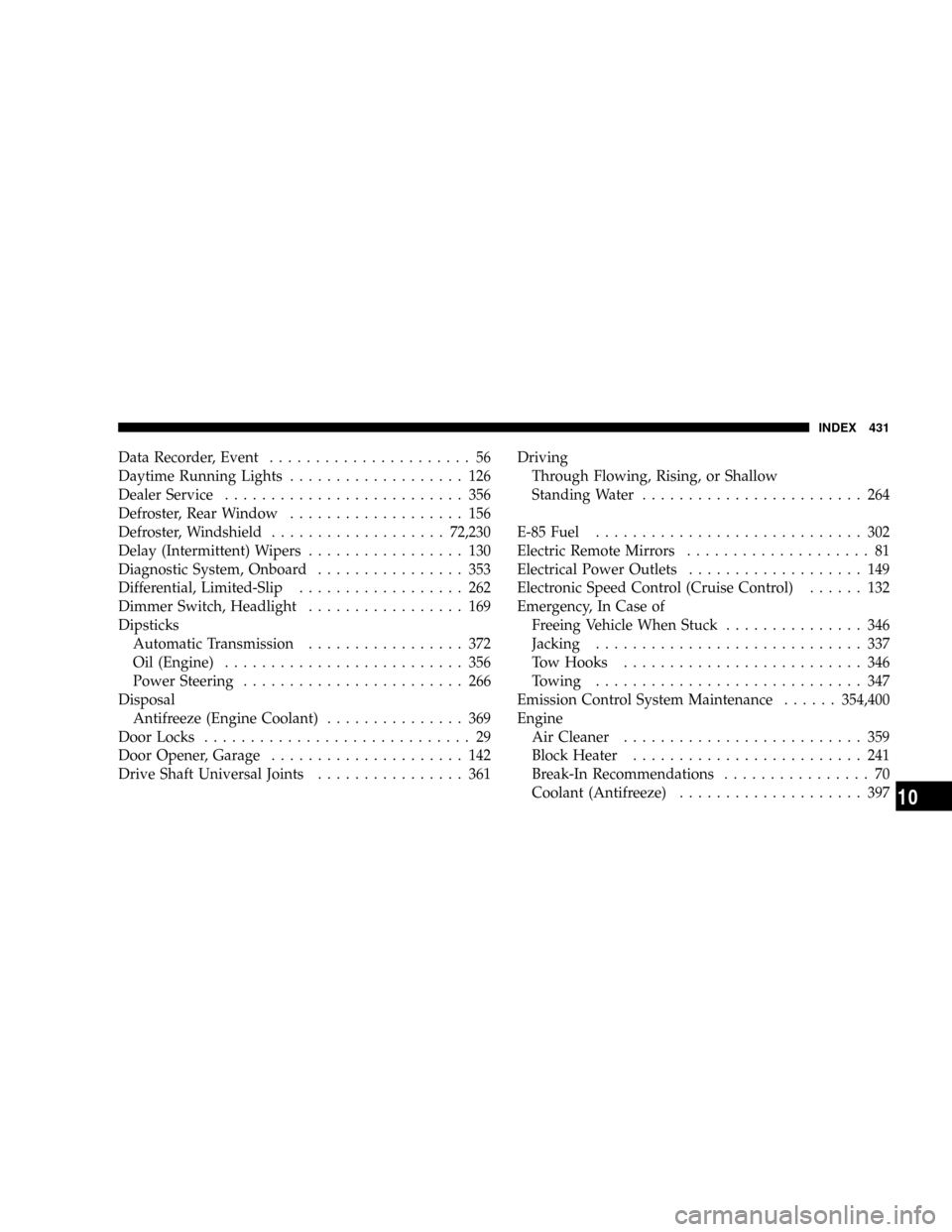
Data Recorder, Event...................... 56
Daytime Running Lights................... 126
Dealer Service.......................... 356
Defroster, Rear Window................... 156
Defroster, Windshield...................72,230
Delay (Intermittent) Wipers................. 130
Diagnostic System, Onboard................ 353
Differential, Limited-Slip.................. 262
Dimmer Switch, Headlight................. 169
Dipsticks
Automatic Transmission................. 372
Oil (Engine).......................... 356
Power Steering........................ 266
Disposal
Antifreeze (Engine Coolant)............... 369
Door Locks............................. 29
Door Opener, Garage..................... 142
Drive Shaft Universal Joints................ 361Driving
Through Flowing, Rising, or Shallow
Standing Water........................ 264
E-85 Fuel............................. 302
Electric Remote Mirrors.................... 81
Electrical Power Outlets................... 149
Electronic Speed Control (Cruise Control)...... 132
Emergency, In Case of
Freeing Vehicle When Stuck............... 346
Jacking............................. 337
Tow Hooks.......................... 346
Towing............................. 347
Emission Control System Maintenance......354,400
Engine
Air Cleaner.......................... 359
Block Heater......................... 241
Break-In Recommendations................ 70
Coolant (Antifreeze).................... 397
INDEX 431
10
Page 440 of 449
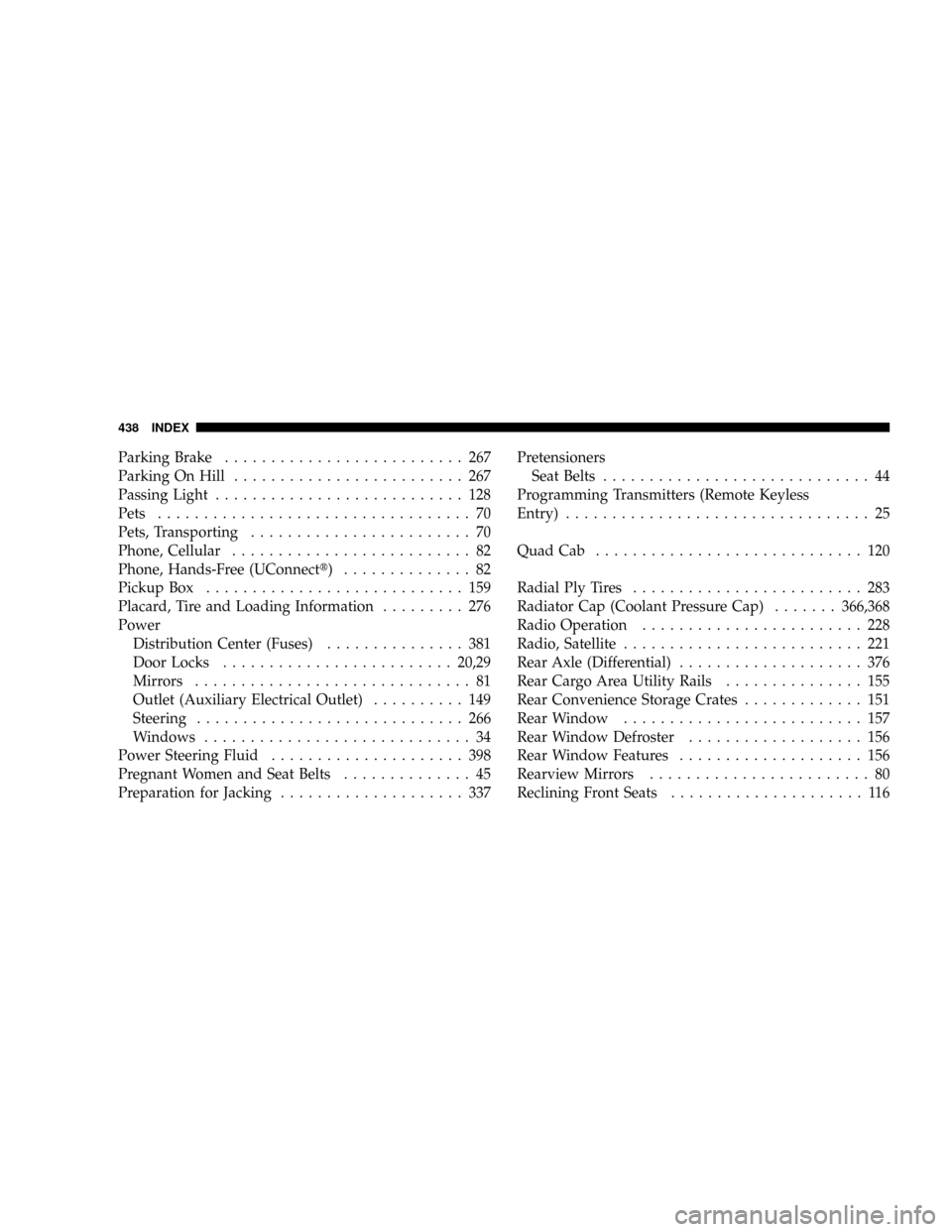
Parking Brake.......................... 267
Parking On Hill......................... 267
Passing Light........................... 128
Pets.................................. 70
Pets, Transporting........................ 70
Phone, Cellular.......................... 82
Phone, Hands-Free (UConnectt) .............. 82
Pickup Box............................ 159
Placard, Tire and Loading Information......... 276
Power
Distribution Center (Fuses)............... 381
Door Locks.........................20,29
Mirrors.............................. 81
Outlet (Auxiliary Electrical Outlet).......... 149
Steering............................. 266
Windows............................. 34
Power Steering Fluid..................... 398
Pregnant Women and Seat Belts.............. 45
Preparation for Jacking.................... 337Pretensioners
Seat Belts............................. 44
Programming Transmitters (Remote Keyless
Entry)................................. 25
Quad Cab............................. 120
Radial Ply Tires......................... 283
Radiator Cap (Coolant Pressure Cap).......366,368
Radio Operation........................ 228
Radio, Satellite.......................... 221
Rear Axle (Differential).................... 376
Rear Cargo Area Utility Rails............... 155
Rear Convenience Storage Crates............. 151
Rear Window.......................... 157
Rear Window Defroster................... 156
Rear Window Features.................... 156
Rearview Mirrors........................ 80
Reclining Front Seats..................... 116
438 INDEX
Page 446 of 449
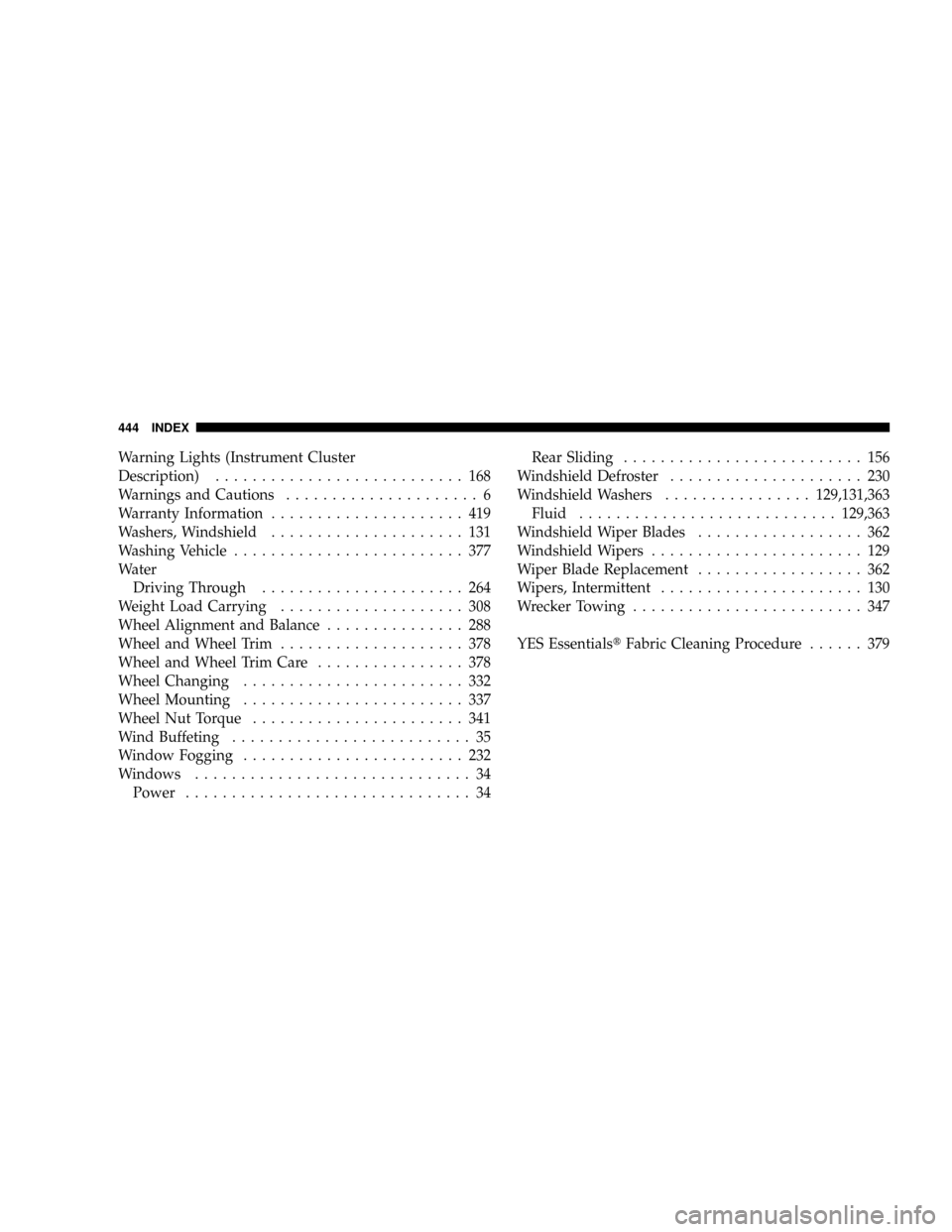
Warning Lights (Instrument Cluster
Description)........................... 168
Warnings and Cautions..................... 6
Warranty Information..................... 419
Washers, Windshield..................... 131
Washing Vehicle......................... 377
Water
Driving Through...................... 264
Weight Load Carrying.................... 308
Wheel Alignment and Balance............... 288
Wheel and Wheel Trim.................... 378
Wheel and Wheel Trim Care................ 378
Wheel Changing........................ 332
Wheel Mounting........................ 337
Wheel Nut Torque....................... 341
Wind Buffeting.......................... 35
Window Fogging........................ 232
Windows.............................. 34
Power............................... 34Rear Sliding.......................... 156
Windshield Defroster..................... 230
Windshield Washers................129,131,363
Fluid............................129,363
Windshield Wiper Blades.................. 362
Windshield Wipers....................... 129
Wiper Blade Replacement.................. 362
Wipers, Intermittent...................... 130
Wrecker Towing......................... 347
YES EssentialstFabric Cleaning Procedure...... 379
444 INDEX